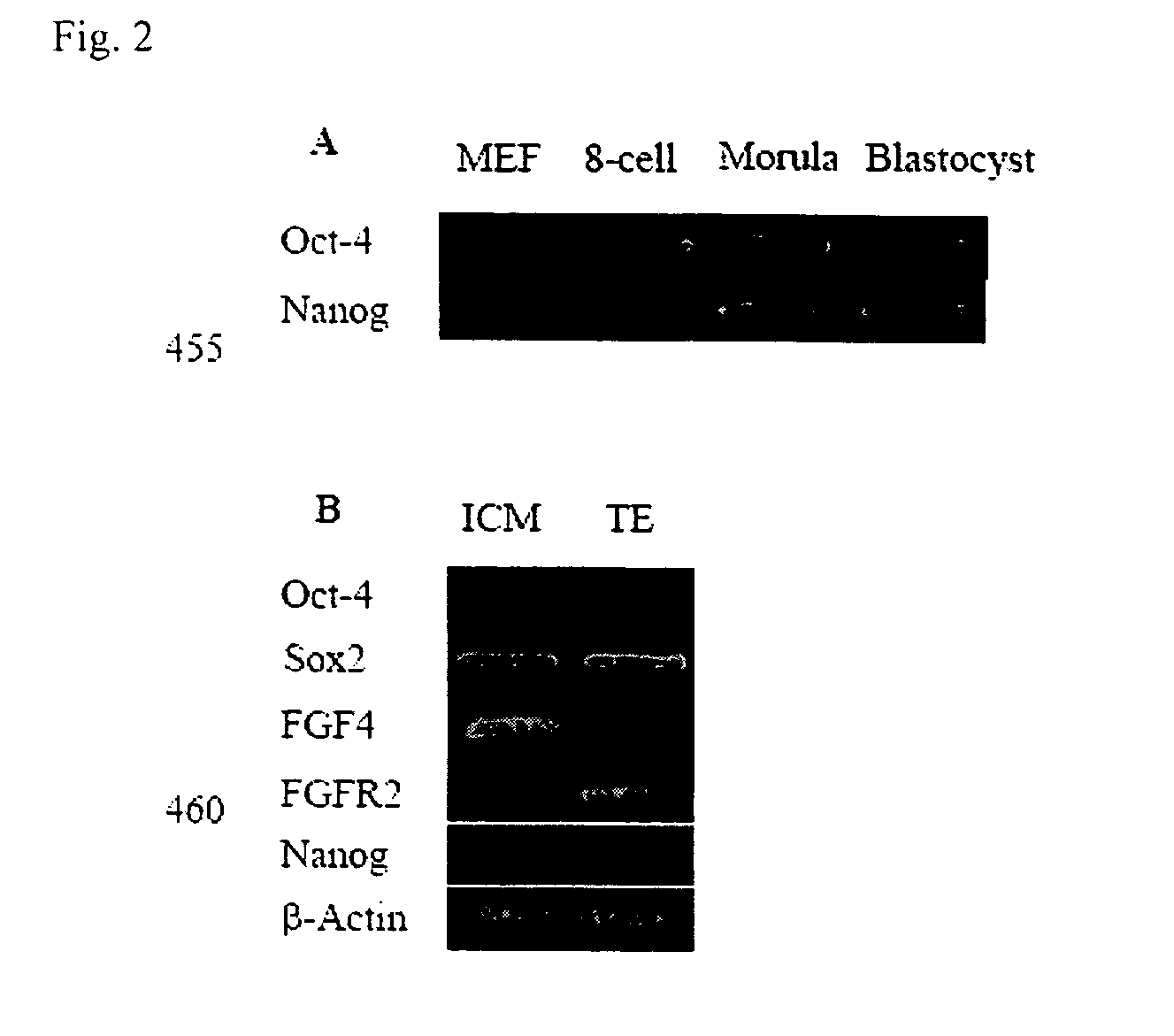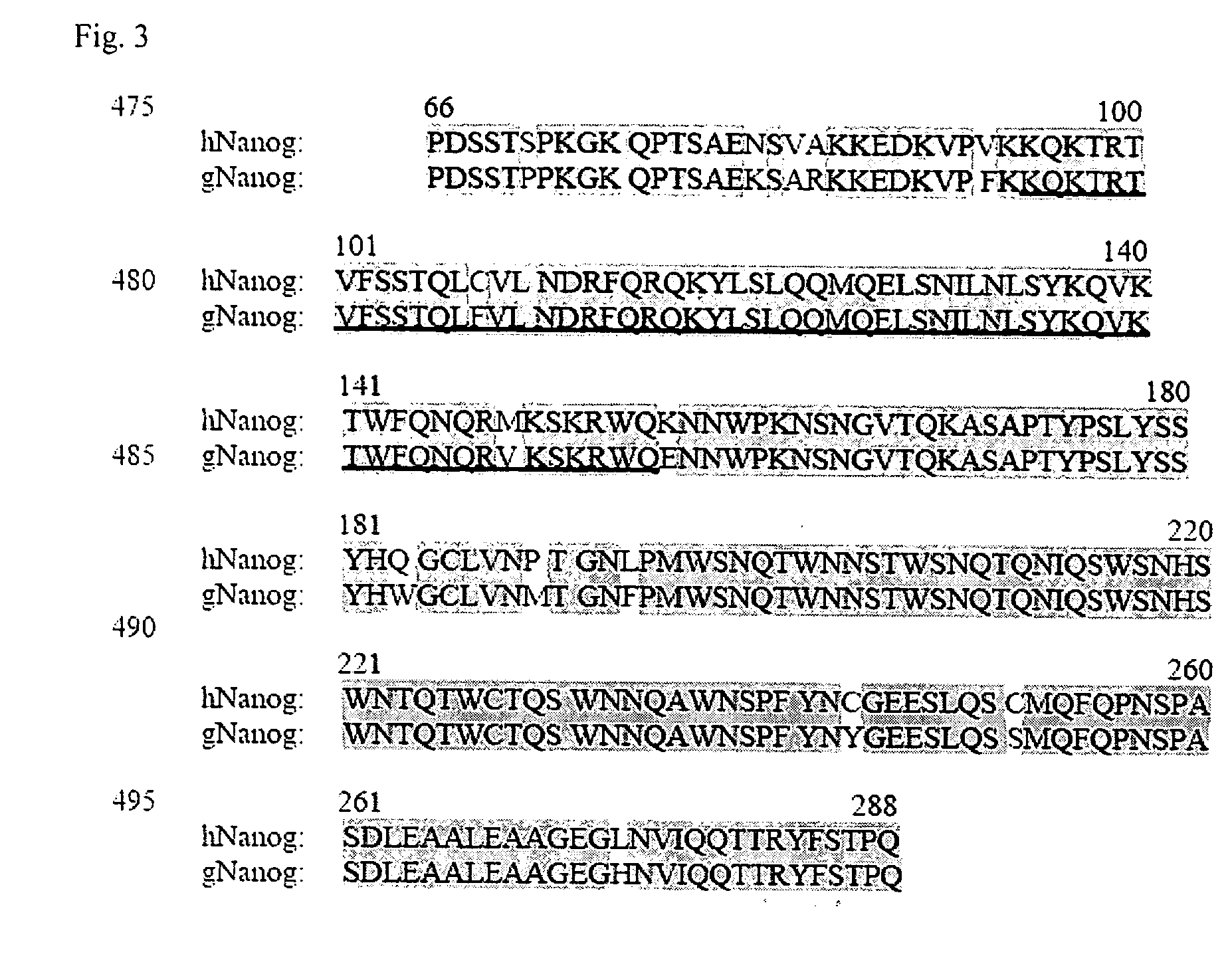Identification and isolation of pluripotency determining factors
a technology of transcription factors and determining factors, which is applied in the field of isolation of pluripotency transcription factors, can solve the problems of loss of pluripotency in both icm and es cells, rapid downregulation of expression in the te, and little information on the expression patterns of these es cell surface markers
- Summary
- Abstract
- Description
- Claims
- Application Information
AI Technical Summary
Problems solved by technology
Method used
Image
Examples
example 1
In Vivo Embryo Collection
[0063] The herds of pure- and mixed-breed, scrapie-free, Alpine, Saanen, and Toggenburg dairy goats used for this study were maintained under Good Agricultural Practice (GAP) guidelines at the GTC Biotherapeutics farm in Massachusetts. Embryo donor does, synchronized and superovulated as previously described, were naturally breed with intact bucks, and / or artificially inseminated with fresh-collected semen. After collection, embryos were cultured in equilibrated M199 (GIBCO) with 10% FBS supplemented with 2 mM L-glutamine and 1% penicillin / streptomycin (10,000 IU / ml each) and shipped in a temperature controlled container (Biotherm portable incubator, Cryologics, Australia) to the University of Maryland by overnight courier.
example 2
Oocyte Maturation, Activation and Parthenogenetic Embryo Culture
[0064] Unless otherwise indicated all chemicals used in embryo culture were obtained from Sigma-Aldrich, St. Louis, Mo., USA. Oocyte maturation medium was TCM199H medium (GIBCO) supplemented with 0.02 units / ml bLH (Sioux Biochemicals, Sioux Center, Iowa), 0.002 units / ml bFSH (Sioux Biochemicals, Sioux Center, Iowa), 1 μg / ml estradiol-17β, 0.2 mM sodium pyruvate, 50 μg / ml gentamycin, 100 μM cysteamine, and 10% heat inactivated goat serum.
[0065] Ovaries were collected at slaughter and transported to the laboratory in warm (33-38° C.) PBS. Oocytes-cumulus complexes (OCC) were obtaining by slicing the ovarian surface with a razorblade. OCC with multiple cumulus layers were selected and washed three times in pre-warmed maturation medium. OCC selected were 115 120 125 130 135 incubated for 28 h at 38.5° C., in 5% CO2. Mature metaphase II oocytes were subsequently activated by incubation with 5 μM ionomycin for 4 min, follow...
example 3
Immunohistochemical Analysis
[0066] At least 6 in vivo- and parthenogenetic-derived goat embryos were examined at the 8-cell, morula and blastocyst (both day 7 and day 10) stages. Embryos were fixed in 4% formaldehyde for 20 min and washed three times with TBST (20 mM Tris-HCl, 0.15 M NaCl, and 0.05% Tween-20, pH 7.4, Sigma-Aldrich). After permeabilization with 0.2% Triton X-100 and 0.1% Tween-20 for 10 min, nonspecific reactions were blocked with 10% normal sheep serum (Sigma-Aldrich) for 30 min at room temperature. Embryos were then incubated overnight at 4° C. in mouse monoclonal antibodies, including Oct-4 (1:40; Santa Cruz Biotechnology, Inc., Santa Cruz, Calif.), SSEA1, SSEA4, TRA-1-60 and TRA-1-81 (1:50; ES cell characterization kit, Chemicon, Temecula, Calif.). After extensive washing with TBST buffer, embryos were exposed to sheep anti-mouse secondary antibody conjugated with FITC (1:30; Chemicon, Temecula, Calif.) for 30 min at room temperature. Either the primary antibody...
PUM
| Property | Measurement | Unit |
|---|---|---|
| length | aaaaa | aaaaa |
| pH | aaaaa | aaaaa |
| temperature | aaaaa | aaaaa |
Abstract
Description
Claims
Application Information
 Login to view more
Login to view more - R&D Engineer
- R&D Manager
- IP Professional
- Industry Leading Data Capabilities
- Powerful AI technology
- Patent DNA Extraction
Browse by: Latest US Patents, China's latest patents, Technical Efficacy Thesaurus, Application Domain, Technology Topic.
© 2024 PatSnap. All rights reserved.Legal|Privacy policy|Modern Slavery Act Transparency Statement|Sitemap



